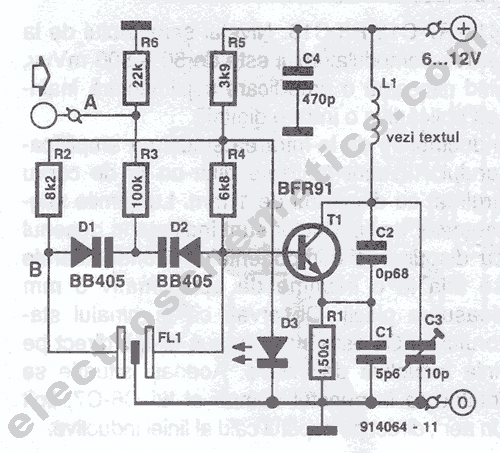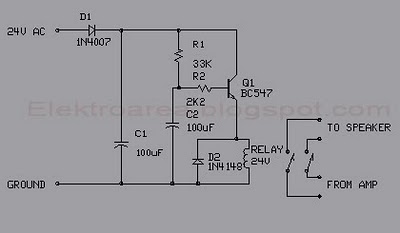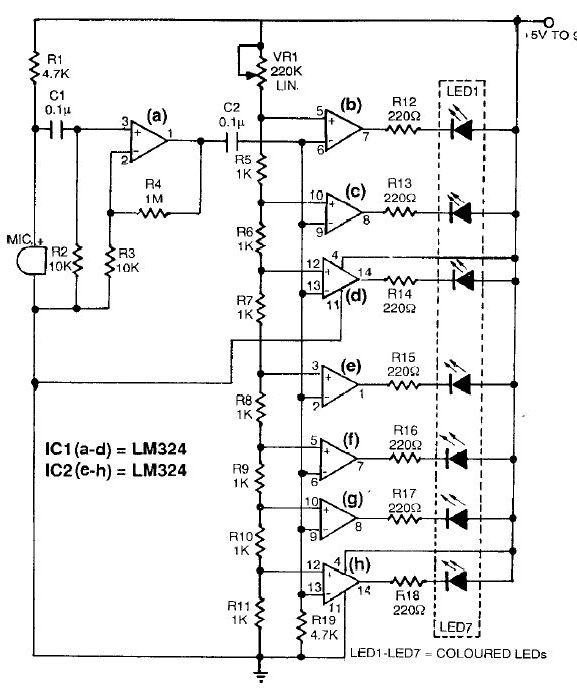
Multitone Siren circuit

This multi-tone siren is beneficial for burglar alarms, reverse horns, and similar applications. It generates five distinct audio tones, making it more attention-grabbing than a single-tone siren. The circuit is designed around the widely used CMOS oscillator and divider IC 4060, along with the small audio amplifier LM386. The IC 4060 serves as the multi-tone generator. A 100µH inductor is connected at the input of IC 4060, allowing it to oscillate within an approximate range of 5 MHz RF. The IC 4060 divides the RF signals into audio frequency (AF) and ultrasonic ranges. Different frequency audio signals can be accessed at pins 1, 2, 3, 13, and 15 of IC 4060 (IC1).
The multi-tone siren circuit employs the CMOS IC 4060 as the core component for generating various audio tones. The operation begins with the 100µH inductor, which forms part of the oscillator circuit, enabling the IC to generate signals in the radio frequency range. The IC 4060's internal structure includes a series of flip-flops that divide the frequency of the oscillating signal, producing a range of lower frequency outputs suitable for audio applications.
The outputs from the IC 4060 are accessible at designated pins, allowing for the selection of different tones. Pins 1, 2, and 3 provide audio signals at varying frequencies, while pins 13 and 15 extend the tonal variety into the ultrasonic range. This flexibility allows the circuit to create distinct sound patterns, which can be particularly effective in alert systems, drawing attention more effectively than conventional single-tone alarms.
To amplify the generated audio signals, the LM386 audio amplifier is integrated into the circuit. This amplifier is known for its low power consumption and ability to drive small speakers or piezoelectric buzzers, making it an ideal choice for battery-operated alarm systems. The output from the LM386 ensures that the tones produced by the IC 4060 are sufficiently loud to be heard clearly in various environments.
Overall, this multi-tone siren circuit is a practical solution for enhancing alarm systems, offering a range of sounds that can deter intruders and alert users effectively. The combination of the IC 4060 and LM386 provides a compact and efficient design suitable for various applications requiring audible alerts.This multi-tone siren is useful for burglar alarms, reverse horns, etc. It produces five different audio tones and is much more ear-catching than a single-tone siren. The circuit is built around popular CMOS oscillator-cum-divider IC 4060 and small audio amplifier LM386. IC 4060 is used as the mult-itone generator. A 100µH inductor is used at the input of IC 4060. So it oscillates within the range of about 5MHz RF. IC 4060 itself divides RF signals into AF and ultrasonic ranges. Audio signals of different frequencies are available at pins 1, 2, 3, 13 and 15 of IC 4060 (IC1).. 🔗 External reference
The multi-tone siren circuit employs the CMOS IC 4060 as the core component for generating various audio tones. The operation begins with the 100µH inductor, which forms part of the oscillator circuit, enabling the IC to generate signals in the radio frequency range. The IC 4060's internal structure includes a series of flip-flops that divide the frequency of the oscillating signal, producing a range of lower frequency outputs suitable for audio applications.
The outputs from the IC 4060 are accessible at designated pins, allowing for the selection of different tones. Pins 1, 2, and 3 provide audio signals at varying frequencies, while pins 13 and 15 extend the tonal variety into the ultrasonic range. This flexibility allows the circuit to create distinct sound patterns, which can be particularly effective in alert systems, drawing attention more effectively than conventional single-tone alarms.
To amplify the generated audio signals, the LM386 audio amplifier is integrated into the circuit. This amplifier is known for its low power consumption and ability to drive small speakers or piezoelectric buzzers, making it an ideal choice for battery-operated alarm systems. The output from the LM386 ensures that the tones produced by the IC 4060 are sufficiently loud to be heard clearly in various environments.
Overall, this multi-tone siren circuit is a practical solution for enhancing alarm systems, offering a range of sounds that can deter intruders and alert users effectively. The combination of the IC 4060 and LM386 provides a compact and efficient design suitable for various applications requiring audible alerts.This multi-tone siren is useful for burglar alarms, reverse horns, etc. It produces five different audio tones and is much more ear-catching than a single-tone siren. The circuit is built around popular CMOS oscillator-cum-divider IC 4060 and small audio amplifier LM386. IC 4060 is used as the mult-itone generator. A 100µH inductor is used at the input of IC 4060. So it oscillates within the range of about 5MHz RF. IC 4060 itself divides RF signals into AF and ultrasonic ranges. Audio signals of different frequencies are available at pins 1, 2, 3, 13 and 15 of IC 4060 (IC1).. 🔗 External reference





